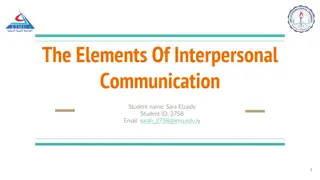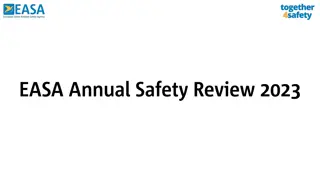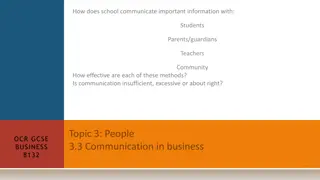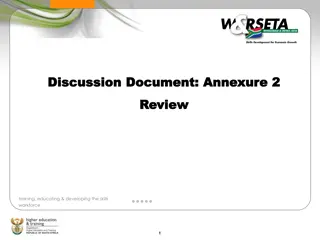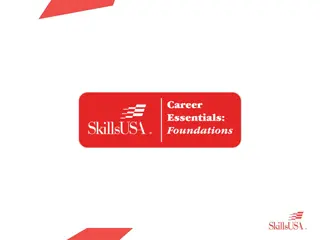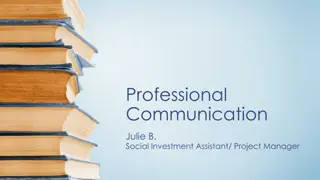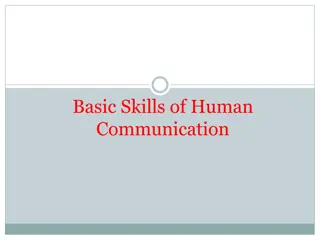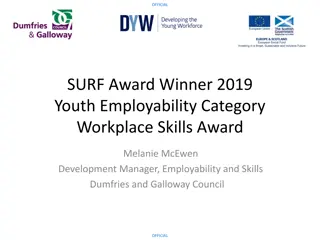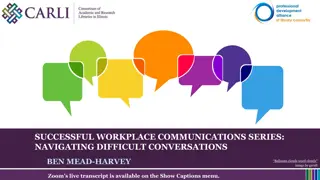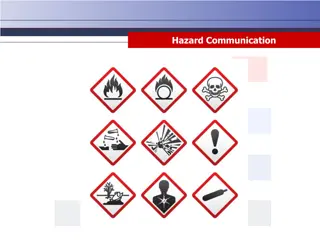Enhancing Effective Communication Skills in the Workplace
Develop essential people skills for successful interactions with colleagues and external contacts. Discover the benefits of effective communication, methods like active listening and assertiveness, and tips for fostering better relationships and resolving conflicts in the workplace.
Download Presentation

Please find below an Image/Link to download the presentation.
The content on the website is provided AS IS for your information and personal use only. It may not be sold, licensed, or shared on other websites without obtaining consent from the author. Download presentation by click this link. If you encounter any issues during the download, it is possible that the publisher has removed the file from their server.
E N D
Presentation Transcript
VP, Client Services ESI Employee Services Inc. Effective Colleague Communication
No matter what your line of work, your degree of success depends on your ability to interact effectively with other people. From The 5 Essential People Skills by Dale Carnegie
Overview Communication Methods Active Listening Assertiveness Benefits of Effective Communication Four Sentence Model Approach
Who do you interact with? Internal fellow employees in different departments/roles in the college External students, visitors, phone, vendors
Introduction Despite the increase in use of the internet, cell phones, and computers, effective people skills remain the most valuable skills in a workplace
Communicating is easy!! True or False?
The Benefits of Effective Communication Needed information is conveyed to everyone Better morale within departments and the MBCC community Higher level of motivation and productivity Less employee conflict and more cooperation
Encourage Relationship Building Team members should try to get to know one another within the work setting. You don't have to likeeverybody on the team. That s just not realistic! Be willing to acknowledge someone s extra efforts in assisting you.
Be constantly aware of others feelings! Disagreements are a part of life and certainly the workplace is not immune. An angry or agitated person will not be able to work towards a solution until they feel understood Give co-workers the benefit of the doubt Resolution of the problem is the goal- aim to resolve not win
Recognize that a perfect world is usually an illusion! From time to time, workloads and tasks will be uneven Seeking that perfect world invariably leads to stress, discomfort and sometimes anger Everything we do impacts each other, the department, and the school environment
Managing Conflict Conflict is a natural part of life. Managing conflict is a process to reduce the negative outcomes of the opposing forces, resolve the issue creating the negative interaction, and improve the chances that something positive will come out of the experience.
The Iceberg of Conflict Issue Personality Emotions Interests, Needs and Desires Self-Perceptions and Self-Esteem Hidden Expectations Unresolved Issues from the Past
What Constitutes Effective Communication? Being respectful Hearing what is said Saying what you mean Working together to achieve results
Respect is a key element in effective communication
RESPECT= I care about you Definition:Respect denotes both a positive feeling of esteem for a person and also specific actions and conduct representative of that esteem. Showing consideration, courtesy, and care for someone or something.
What Respectlooks like: Listening Giving clear instructions Criticizing/Giving Feedback in private Sensitivity to others personal boundaries Apologizing for mistakes
What Respectlooks like: Acknowledging colleagues Offering praise when appropriate Greeting one another Responding to greetings No passive-aggressive behavior Honoring commitments Being on time No putdown gestures
Why choose to be Respectful? One person can have a positive impact on the work environment a) Improved morale b) Improved productivity c) Improved teamwork Being nice feels good Communication becomes more effective
What disrespect looks like: Finger wagging You-statements Yelling Broken promises Sarcasm Chronic lateness Never owning a mistake Name calling Accusatory questions Interrupting Completing sentences Criticizing in public Patronizing smile
Disrespect leads to: Resentment Lack of cooperation Hostility Opposition Antagonism Turnover Lawsuits
Methods of Communication Sometimes it is not Whatyou say but Howyou say it
Verbal Communication Non-Verbal Communication Words Body Language Voice Arms crossed, appearing relaxed or tense, etc Pitch Emotion of the sender and receiver Pace Excited, anger, upset, etc Non-verbal cues Eye contact, facial expressions, hand gestures, etc
Verbal and Non-Verbal Communication According to a study at the University of California, credibility/believability of a message is transmitted through words, voice, facial expressions, and body language 7% Words Content 38% Voice Tone, projection, resonance 55% Facial Expressions and Body Language
Communication - The Process In any communication, at least some of the meaning is lost The message that is heard is often far different than the one intended due to a variety of factors
Some Barriers to Effective Communication Misreading body language, tone, and other non-verbal signs Selective hearing Defensiveness A climate that does not support communication Taking communication for granted Not having the skills to communicate well
Listening skills are a key element in effective communication
Active Listening Listening means gaining an understanding of the point of view of the speaker VS. Hearing involves using the ears to react to the sound of someone talking
Active Listening There are four steps to Active Listening: Reflect and Paraphrase - When you paraphrase, you repeat back to the speaker a summary of what you believe was said. Ask open-ended questions - Ask the speaker questions as a way to invite the speaker to elaborate on his or her ideas. Use I statements - Using I statements places the burden of understanding on you rather than on the speaker. Saying to someone, You re not making any sense may cause defensiveness. Instead you might say, I m a little confused. Could you clarify this for me? Monitor Body Language - Be aware of your body language and the non-verbal messages you are sending. Use body language that conveys friendliness, openness, and interest.
Barriers to Active Listening Mind reading Interrupting Filtering Rehearsing Distraction
Assertiveness is a key element in effective communication
Assertive Communication Assertiveness is key in being able to effectively communicate Assertiveness is the middle ground between being passive or being aggressive
Assertive Communication Assumes that I have the right to express myself and be heard, and so do you, even if we do not agree If I use assertive communication techniques, I will: Take responsibility for my own thoughts and feelings Talk about your actions, not character
Assertive vs. Other Styles Assertive Aggressive Passive Your point of view is more important than mine Here s my point of view Do it my way! So, I won t express myself with conviction I m not imposing it on you; I m just expressing myself as clearly as possible If you don t agree with me, you re wrong and I ll put you down for it
Assertiveness is not Aggressive Passive Pushy Overly compliant Arrogantly demanding Disrespectful of one s own interests and ideas Righteous Indirect Self-centered Being a pushover Making others feel humiliated and defensive Allowing others to choose or make decisions for us
Something to think about Not everyone needs to work on being more Not everyone needs to work on being more assertive. Some people are naturally assertive and assertive. Some people are naturally assertive and just need to learn how to stand up to overly just need to learn how to stand up to overly dominant personalities. dominant personalities.
Negative Reactions Others may respond to you being assertive in either a passive aggressive or aggressive way It is important to know how to deal with those reactions
How to Respond Limit your body language Pay attention to your tone of voice Present your message in a clear and concise way Know when to end an interaction that is escalating
Smile, even when you dont feel like it Presenting a warm and engaging attitude creates an emotional contagion that invites civility and cooperation even in challenging situations.
The Four Sentence Model is a key element of effective communication
Four Sentence Model Approach One Part Message - Use I statements. I think/feel/believe We say directly that we see, feel, hear or believe without labeling or blaming others Two Part Message When you then allows us to comment on behavior and its impact without labeling or criticizing.
Four Sentence Model Approach (contd) Three Part Message - When you , I feel because Four Part Message - When you , I feel, I understand , and I need/want Statements of understanding combined with statements of need. Acknowledges the other person's feelings and concerns while at the same time affirming one s own needs as well.
Four Sentence Model Approach Example: When you come in late every Monday, I feel angry because I have When you come in late every Monday, I feel angry because I have to do your work. I understand you may have a transportation to do your work. I understand you may have a transportation problem, but I need you to be here on time so we can help each problem, but I need you to be here on time so we can help each other out with the Monday morning responsibilities. other out with the Monday morning responsibilities.
Summary Be aware of what you say and how you say it Practice active listening skills Utilize assertiveness skills Use the Four Sentence Model Approach
Call for counseling assistance: 1-800-252-4555 Visit the EAP website: www.higheredeap.com Download the EAP App Go to the App Store -Search EAP
The Leader in Productivity Solutions More benefits More programs More value than any other EAP




